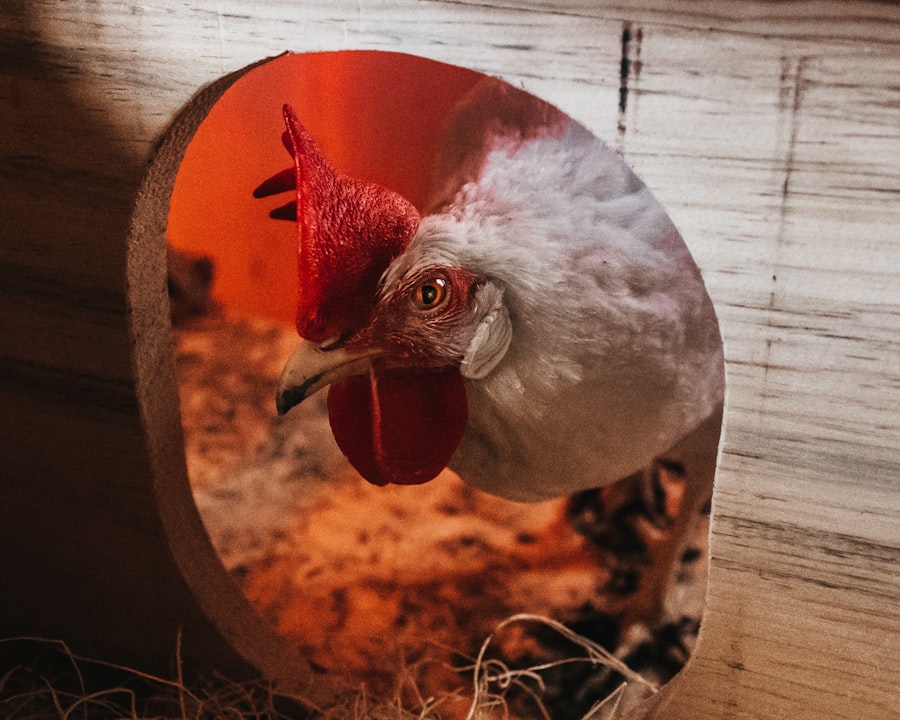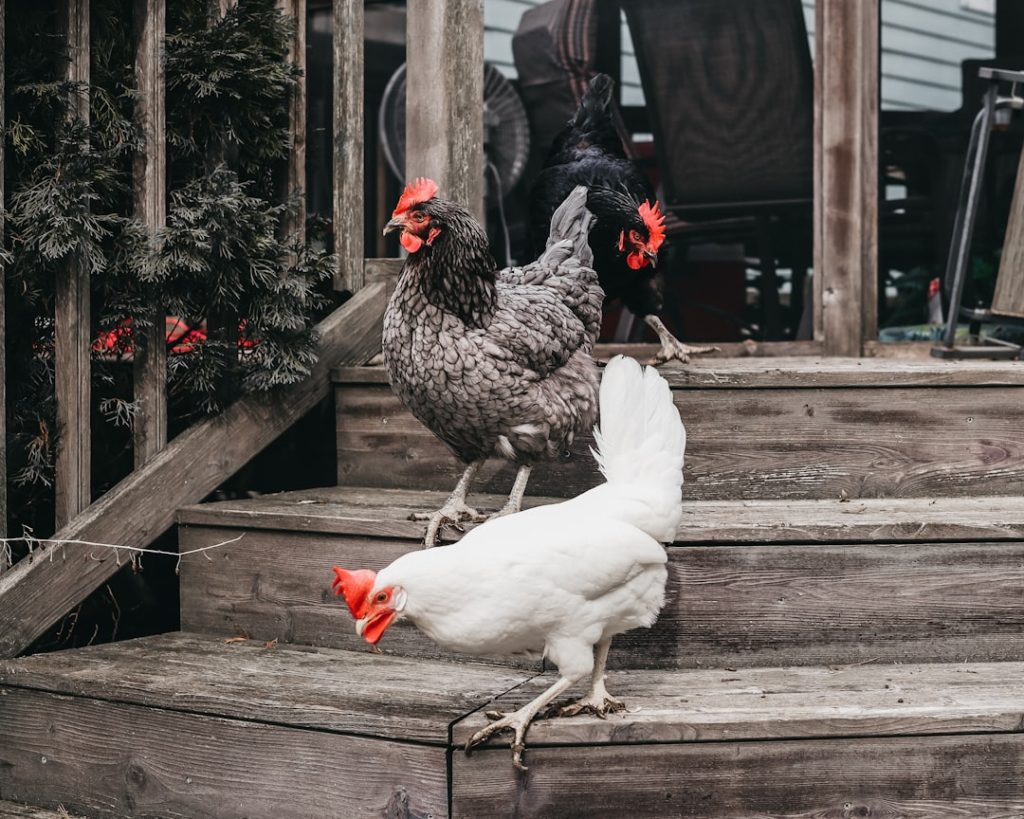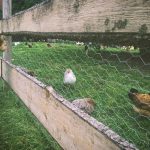Chickens are prey animals with a strong instinct to flee from potential threats. They are highly social creatures that maintain a complex social hierarchy within their flock. In contrast, dogs are natural predators with a strong prey drive.
As pack animals, dogs also have an instinct to establish and maintain a social hierarchy within their group. Understanding these innate behaviors is essential when considering keeping chickens and dogs together. Chickens possess a natural fear of predators, including dogs, and will instinctively attempt to escape from them.
Dogs, conversely, have an inherent drive to chase and potentially harm small animals like chickens. When introducing chickens and dogs to each other, it is crucial to consider these natural instincts and take appropriate measures to ensure the safety and well-being of both species.
Table of Contents
- 1 Creating a secure and safe coop for chickens
- 2 Training and socializing dogs to be around chickens
- 3 Using physical barriers to separate chickens and dogs
- 4 Providing adequate exercise and mental stimulation for dogs
- 5 Supervising interactions between chickens and dogs
- 6 Seeking professional help if necessary
- 7 FAQs
Key Takeaways
- Chickens have natural instincts to peck, scratch, and roost, and they are prey animals with a strong flock mentality
- A secure coop for chickens should have strong fencing, predator-proof locks, and adequate ventilation and lighting
- Dogs can be trained to be calm and gentle around chickens through positive reinforcement and socialization
- Physical barriers such as fences and gates can be used to separate chickens and dogs when they are not supervised
- Dogs need regular exercise and mental stimulation to prevent boredom and potential aggression towards chickens
- Interactions between chickens and dogs should be closely supervised to ensure the safety of both animals
- Seeking professional help from a trainer or behaviorist may be necessary if there are persistent issues with the relationship between chickens and dogs
Creating a secure and safe coop for chickens
Secure Coop Construction
One of the most important steps in keeping chickens and dogs together is to create a secure and safe coop for the chickens. This means providing a sturdy and predator-proof enclosure that will keep the chickens safe from potential threats, including dogs. The coop should be constructed with strong materials and secure locks to prevent any unwanted entry by dogs or other predators.
Providing Adequate Space
In addition to a secure coop, it is also important to provide adequate space for the chickens to roam and forage. This can help reduce stress and aggression among the flock, as well as provide mental stimulation for the chickens.
Creating a Comfortable Environment
Providing perches and hiding spots within the coop can also help the chickens feel safe and secure, especially when dogs are present. This can help reduce stress and anxiety, and create a comfortable environment for the chickens to thrive.

When it comes to keeping chickens and dogs together, it is important to train and socialize the dogs to be around the chickens. This can help reduce the risk of aggression or predatory behavior from the dogs, and can help create a harmonious environment for both animals. Training should begin with basic obedience commands, such as “sit,” “stay,” and “leave it,” which can help control the dog’s behavior around the chickens.
Socializing the dog to be around the chickens should be done gradually and under controlled circumstances. This can include supervised interactions with the chickens while on a leash, as well as positive reinforcement for calm and non-aggressive behavior around the chickens. It is important to monitor the dog’s body language and behavior during these interactions, and to intervene if any signs of aggression or predatory behavior are observed.
Using physical barriers to separate chickens and dogs
In addition to training and socializing the dogs, it is also important to use physical barriers to separate the chickens and dogs when necessary. This can include using fences or gates to create separate areas for the chickens and dogs, especially when they are unsupervised. It is important to ensure that these barriers are secure and cannot be easily breached by the dogs, as well as providing adequate space for both animals to move around freely.
Using physical barriers can help prevent any unwanted interactions between the chickens and dogs, and can help reduce the risk of injury or stress for both animals. It is important to regularly inspect these barriers for any signs of wear or damage, and to make any necessary repairs or adjustments to ensure their effectiveness.
Providing adequate exercise and mental stimulation for dogs
When keeping chickens and dogs together, it is important to provide adequate exercise and mental stimulation for the dogs. This can help reduce boredom and potential predatory behavior towards the chickens, as well as promote overall health and well-being for the dogs. Regular walks, playtime, and interactive toys can help keep the dogs physically and mentally stimulated, which can help reduce any potential aggression or predatory behavior towards the chickens.
In addition to physical exercise, it is also important to provide mental stimulation for the dogs through training and enrichment activities. This can include obedience training, puzzle toys, and scent work, which can help keep the dogs engaged and focused on positive behaviors. Providing adequate exercise and mental stimulation for the dogs can help reduce any potential stress or frustration that may lead to aggressive behavior towards the chickens.
Supervising interactions between chickens and dogs

Supervise Interactions Closely
One of the most important aspects of keeping chickens and dogs together is to supervise their interactions at all times. This can help ensure the safety and well-being of both animals, as well as prevent any potential conflicts or injuries. Supervision should include monitoring the body language and behavior of both animals, as well as intervening if any signs of aggression or predatory behavior are observed.
Establish Clear Boundaries and Rules
It is important to establish clear boundaries and rules for both the chickens and dogs when they are together, and to enforce these rules consistently. This can include teaching the dogs to respect the space of the chickens, as well as providing safe areas for the chickens to retreat to if they feel threatened.
Positive Reinforcement is Key
It is also important to provide positive reinforcement for calm and non-aggressive behavior from both animals during their interactions. By doing so, you can encourage harmonious coexistence between your chickens and dogs.
Seeking professional help if necessary
If keeping chickens and dogs together proves to be challenging or if there are any signs of aggression or stress from either animal, it may be necessary to seek professional help. This can include consulting with a veterinarian, animal behaviorist, or experienced trainer who can provide guidance and support for managing the relationship between the chickens and dogs. Professional help can also be beneficial in addressing any underlying issues that may be contributing to any conflicts or aggression between the animals.
In some cases, it may be necessary to temporarily separate the chickens and dogs while working with a professional to address any behavioral issues or concerns. This can help reduce any potential risks or conflicts between the animals while a plan is developed for safely reintroducing them. Seeking professional help if necessary can help ensure the safety and well-being of both the chickens and dogs, as well as promote a harmonious relationship between them in the long term.
In conclusion, keeping chickens and dogs together can be a rewarding experience with proper planning, training, and supervision. Understanding the natural instincts of both animals, creating a secure coop for the chickens, training and socializing the dogs, using physical barriers when necessary, providing adequate exercise and mental stimulation for the dogs, supervising their interactions, and seeking professional help if necessary are all important aspects of successfully keeping chickens and dogs together. With careful consideration and proactive management, it is possible for chickens and dogs to coexist peacefully and harmoniously in a shared environment.
If you’re looking for ways to keep your chickens safe from predators like dogs, you may also be interested in learning about the benefits of using a heater for a chicken coop. This article from Poultry Wizard discusses the importance of keeping your chickens warm and comfortable during colder months, which can also help deter predators. Check out the article here for more information on how to keep your chickens safe and cozy.
FAQs
What are some effective ways to keep chickens safe from dogs?
Some effective ways to keep chickens safe from dogs include building a secure coop and run, using fencing and barriers to keep dogs out, and training dogs to not chase or harm chickens.
How can I build a secure coop and run for my chickens?
To build a secure coop and run for your chickens, use sturdy materials such as hardware cloth or welded wire to prevent dogs from gaining access. Make sure the coop has a secure door and that the run is fully enclosed with a roof to prevent dogs from jumping in.
What types of fencing and barriers can be used to keep dogs away from chickens?
Fencing options such as electric fencing, chain link fencing, or even a double fence system can be effective in keeping dogs away from chickens. Barriers such as chicken wire or netting can also be used to create a physical barrier between the chickens and dogs.
How can I train my dog to not chase or harm chickens?
Training your dog to not chase or harm chickens involves consistent and positive reinforcement. Use commands such as “leave it” or “stay” when the dog shows interest in the chickens, and reward the dog for obeying. Supervised interactions between the dog and chickens can also help reinforce positive behavior.
Meet Walter, the feathered-friend fanatic of Florida! Nestled in the sunshine state, Walter struts through life with his feathered companions, clucking his way to happiness. With a coop that’s fancier than a five-star hotel, he’s the Don Juan of the chicken world. When he’s not teaching his hens to do the cha-cha, you’ll find him in a heated debate with his prized rooster, Sir Clucks-a-Lot. Walter’s poultry passion is no yolk; he’s the sunny-side-up guy you never knew you needed in your flock of friends!







